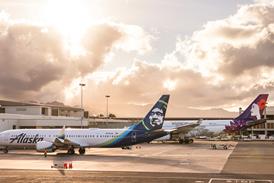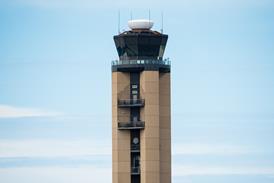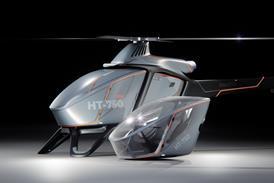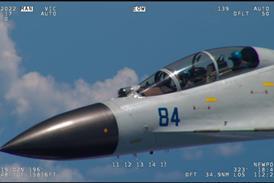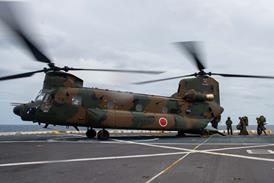It has become fashionable to talk of fighters in terms of generations that broadly describe their capabilities. Within this paradigm the F-15, F-16 and F-18 represent the fourth generation, while Lockheed Martin and the US Air Force have laid claim to the fifth generation with the F-22 and F-35. This groups the best of the rest - Gripen, Super Hornet, Typhoon and Rafale - within "generation 4.5", a label disputed by their manufacturers.
But whatever distinguishes a fifth-generation fighter - and the definition has evolved from F-22 to F-35 - the combination of intrinsic stealth and integrated sensors sets these aircraft apart. It may lack the F-22's supercruise and thrust-vector manoeuverability, but the F-35 promises a more-affordable, multi-role capability. It will also come in three versions: conventional take-off and landing, short take-off and vertical landing and carrier-based.
How effectively the F-35's fifth-generation capabilites can be employed will depend to a large extent on the effectiveness of what Lockheed calls the "pilot vehicle interface". Here sensor, system and weapon capabilities must come together in a way that allows the pilot to focus on managing the mission and not flying the aircraft.
The F-35 mission system will fuse data from a number of active and passive sensors. These include the Northrop Grumman APG-81 actively electronically scanned array radar, while under the nose is a faceted "window" for the Lockheed electro-optical targeting system (EOTS), comprising a gimballed infrared sensor and laser.
The most intriguing passive sensor on the F-35 is the Northrop distributed aperture system (DAS). This has six staring uncooled infrared sensors located around the aircraft to provide a spherical view of the world surrounding the F-35. The IR imagery is presented in the pilot's helmet-mounted display and allows him to "see through" the aircraft. Imagery can also be presented on the main 20 x 8in (50 x 20cm) cockpit display. DAS and HMD combine to eliminate the need for night vision goggles.
Advanced datalink
In addition to its on-board sensors, there are two datalink systems. The first is Link 16, which allows any number of off-board sources to send data to the F-35. The second is the JSF-specific multi-advanced datalink, which connects the F-35s in a formation and allows them to see each other's tactical data.
Flight International was able to experience the F-35's cockpit first hand during a recent visit to Lockheed's Fort Worth, Texas facility. Hosted by test pilot David "Doc" Nelson, I was shown around AA-1, the first F-35 test aircraft, to get a feel for the cockpit and how it compares with the F-16, a fighter with which I am familiar. I then "flew" the F-35 PVI development simulator, a fixed-base cockpit mockup with working displays and controls.
My first impression on climbing into AA-1 was that the ejection seat, by Martin-Baker, is lower in the airframe than in the F-16. Pilots used to the F-16's single-piece canopy will at first be disappointed by the F-35's canopy bow. Its main purpose is to fuse the transparency's two sections. The forward section is designed to withstand a birdstrike at high speed and low altitude. The larger and thinner aft section is flat at the sides, to reduce radar returns. A detonating cord splits the aft section in half and creates an opening for the seat, improving low-altitude and low-speed ejection survivability - especially critical in STOVL operations.
Field of view over the nose is excellent, enhanced by the small radome enclosing the active-array radar. AA-1 is a CTOL variant, and FoV back towards the 6 o'clock position between the twin tails was good, but not as good as in an F-16. Nelson says the rearward visibility in the F-35B STOVL variant will be compromised by the bump for the lift fan aft of the cockpit. The cockpit itself is quite wide and felt spacious compared with an F-16's. The seat is adjustable electrically up and down, with rudder pedals manually adjustable.
On hand for my familiarisation with the cockpit systems in the simulator was Mike Skaff, senior manager F-35 PVI. Overall, the simulator was little changed from the JSF cockpit concept demonstrator he had shown me during a visit to Fort Worth seven years earlier. But this time the avionics software represented the Block 3 mission-system standard planned for the F-35 at entry into service.
There is one major change to the F-35 cockpit - the main panel now comprises two 10 x 8in liquid-crystal displays mounted side-by-side. Supplied by L-3 Communications, these replace the single 20 x 8in rear-projection screen and dual projectors used in AA-1.
The F-35 will employ a Vision Systems International HMD as the primary flight instrument, and there is no conventional head-up display on the glareshield. I was able to try on the helmet, which uses binocular optics to project symbology and imagery on to the visor, giving the pilot an extreme off-axis targeting capability. It weighed less than a comparable helmet fitted with separate NVGs.
Seated in the simulator, my left hand fell to the large throttle, called the "cow pie" due to its size and shape, which moves along a long linear track. The active throttle is back-driven by the autothrottle system and has variable electronic detents for afterburner and STOVL operations. There is no "cut-off" position, a single guarded engine master switch performing that function.
My right hand gripped a sidestick similar in design to that in late-model F-16s, with an adjustable hand rest at its base with a sidewall-mounted armrest located aft. The active sidestick is back driven by the autoflight system and has about 40mm (1.5in) of movement in all directions. Originally it was to be a semi-fixed inceptor like the F-16's, responding to force applied rather than movement, but concerns about the demands of vertical flying led to an active stick.
The F-35 cockpit is notable for its lack of switches, but this is more than made up by the large number on the throttle and stick. There are 14 switches and buttons on the throttle, some of them having five positions. Another 12 are located on the sidestick. At first the sheer number of switches and their placement was bewildering, but after an hour in the PVI simulator I was comfortable using them. Their general layout is similar to other fighters', there were just a lot more of them.
To maintain needed commonality between F-35 versions there have been some compromises in the cockpit, so US Navy pilots will have to get used to firing missles with the red pickle button on the sidestick rather than using a trigger. And all throttles, regardless of the variant, will have the "external lights switch" needed for carrier operations.
Limited voice recognition
While not demonstrated in the PVI simulator, the F-35 will have a limited voice recognition system. F-35 chief test pilot Jon Beesley says "finger activation is faster than voice activation", and Lockeed has chosen to use voice control for housekeeping chores and other tasks that require a lot of manual data entry. As currently envisaged, voice commands will be displayed in a scratchpad in the HMD. Only after the pilot has reviewed and accepted the entry will it be executed by the system.
One enhancement planned is three-dimensional audio. Stereo headphones in the helmet enable threat cues and radio calls to be placed relative to their source, helping the pilot build a better 3D picture of the tactical environment.
The heart of the F-35's cockpit is the large forward display. A 25mm band at the top of the display is dedicated to function access buttons. In the upper left is the "thrustometer", which shows percent of engine thrust in use: 100% is maximum dry and 150%is maximum afterburner. Touching the screen brings up an expanded engine display. A fuel bar is located next to the thrustometer: touching it brings up an expanded fuel system display. Abbreviated stores data is also shown, with the remainder of the bar dedicated to the integrated caution and warning system.
The large lower display area can be divided up into a number of portals of varying sizes - the largest being 10 x 7in, which occupies half the available display area. This area can be further broken down into two portals, each of 5 x 7in. Each of these, in turn, can be split into three portals: one of 5 x 5in at the top with two of 2.5 x 2in below. Display control was fairly intuitive, with blue-hashed corners showing how portals could be expanded. The pilot interacts with the portals either by touching the screen or using the HOTAS switches.
Integrated avionics
The F-35's avionics are highly integrated, and for weapons targeting and employment the system must have a point of interest. A cursor designates the system's point of interest and is controlled by the slew switch/cursor control on the throttle. The cursor navigates within the active portal, indicated by a yellow corner hash mark. The portal of interest (PoI) can be the HMD, DAS, radar, EOTS or tactical situation display (TSD). Changing PoIs is primarily accomplished using the data management switch on the sidestick. The cursor's shape changes as function of the PoI and target type (airborne or surface).
The large display area is a palette on which a detailed picture of the tactical situation can be presented. Fused data from the active and passive sensors, as well as datalink information, is used to present the tactical situation in real time. Typically a pilot will use half the display (10 x 7in) for the TSD. The display scale can be tailored to the situation, with ranges from 18.5km (10nm) to 1,185km available. Own ship position, as well as that of other formation members, is in blue. Ground and airborne points/targets are colour-coded: green friendly, yellow undetermined and red hostile.
Target depictions are graphically coded to indicate where the information came from. For airborne targets, shown as a lollypop, the circle is either hollow, half filled or full. Hollow indicates on-board data alone filled indicates only off-board sensors half filled means both on- and off-board sensors are seeing the target. The stick of the lollypop is at first a velocity vector. When the sensors get a lock, the stick increases in length, approaching but not touching the targeted aircraft. The stick extends to touch the targeted aircraft when the fused sensors determine the F-35 has a launch solution on its target. Geographic boxes/lines can be displayed to show areas such as missile engagement and no-fly zones.
Shoot list
To give me a better feel for the F-35's capabilities, Skaff set up two scenarios, one air-to-air and the other air-to-surface. For the air-to-air engagement, my four-ship formation of F-35s targeted four Red aircraft. Using the cursor I locked on to all four aircraft to develop a shoot list. When locked to a target, an expanded data block is presented on the TSD. This identifies the aircraft type, as determined by the numerous sensors, with system confidence level for the determination. Also presented are target range, closure velocity, aspect angle and which sensors are seeing the target.
The targets now all had upright red triangles over them, with numbers corresponding to their priority in the shoot list. On the lower left-hand corner of the TSD was a relative height scale, which showed the altitude of my aircraft and the four targets on a vertical bar. The red lollypop symbols advanced towards my formation, our presence undetected.
At maximum engagement range, as indicated in the HMD, I launched a generic radar-guided missile at the first aircraft in my shoot list. Using the tactical management switch on the sidestick I stepped through the shoot list to engage the fourth target, leaving numbers two and three for my wingmen. I launched the second missile at number four, and the flight of both missiles was tracked and presented on both the HMD and TSD. Time to impact was also presented, a neat feature. All four Red aircraft destroyed, the exercise was terminated to set up the air-to-surface scenario.
For the ground-attack exercise, the F-35 was positioned north of Nellis AFB, Nevada. The targets, several hangars on the flightline, would be engaged with 1,000lb (450kg) GPS-guided bombs. The cockpit display was configured with a 5 x 7in TSD portal to the far left, 5 x 7in DAS portal middle left, 5 x 7in EOTS portal middle right and 5 x 7in synthetic aperture radar portal far right. After placing the cursor in the SAR portal to designate the PoI, I turned 20e_SDgr away from the target to enhance the Doppler return from the target area.
The time required for the radar to build a usable SAR image was shown. Using the stored SAR picture I slewed the cursor over the first hangar. Next I moved the cursor to the EOTS portal to refine my aimpoint, a first-floor window. The target was designated using the TMS switch, making it the first in my shoot list. A second hangar, further south on the field, was the next target, again selected using the stored SAR picture and the aimpoint refined with the EOTS display.
A total of five targets were designated, each represented on the TSD as an inverted red triangle. Had enemy air defences been present, their altitude-dependent lethality zones would have been presented on the TSD to show areas to avoid on the run-in. The first target on the shoot list was chosen for engagement. Flying towards the target, a launch acceptability region was presented on the TSD, "centred" over the target. Holding the pickle button on the sidestick consented to weapon release. Time to release was presnted in the HMD and TSD.
The second target on the shoot list was the next and last to be engaged. As with the first hangar, the only required pilot action now was to fly the F-35 into the launch basket and consent to bomb release.
While the F-35 is several years away from entering service, Lockheed and its partners appear to be well on the way to fielding a highly integrated fifth-generation fighter. The F-35 may not supercruise or have the manoeuvrability of an F-22, but its stealth is on par with its high-priced stablemate. Combined with fused tactical information from both on- and off-board sensors, stealth should allow the F-35 to engage a wide range of targets - some having no idea what hit them.
Source: Flight International


